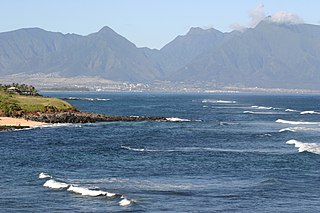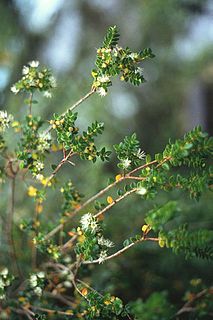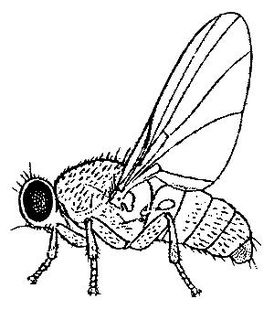
Myrtaceae or the myrtle family is a family of dicotyledonous plants placed within the order Myrtales. Myrtle, pōhutukawa, bay rum tree, clove, guava, acca (feijoa), allspice, and eucalyptus are some notable members of this group. All species are woody, contain essential oils, and have flower parts in multiples of four or five. The leaves are evergreen, alternate to mostly opposite, simple, and usually entire. The flowers have a base number of five petals, though in several genera the petals are minute or absent. The stamens are usually very conspicuous, brightly coloured and numerous.

Metrosideros is a genus of approximately 60 trees, shrubs, and vines mostly found in the Pacific region in the family Myrtaceae. Most of the tree forms are small, but some are exceptionally large, the New Zealand species in particular. The name derives from the Ancient Greek metra or "heartwood" and sideron or "iron". Perhaps the best-known species are the pōhutukawa, northern and southern rātā of New Zealand, and ʻōhiʻa lehua, from the Hawaiian Islands.

Puʻu Kukui is a mountain peak in Hawaiʻi. It is the highest peak of Mauna Kahalawai. The 5,788-foot (1,764 m) summit rises above the Puʻu Kukui Watershed Management Area, an 8,661-acre (35.05 km2) private nature preserve maintained by the Maui Land & Pineapple Company. The peak was formed by a volcano whose caldera eroded into what is now Īʻao Valley.

Angophora costata, commonly known as Sydney red gum, rusty gum or smooth-barked apple, is a species of tree that is endemic to eastern Australia. Reaching 30 m (100 ft) in height, the species has distinctive smooth bark that is pinkish or orange-brown when new and fades to grey with age. Its lance-shaped leaves are arranged in opposite pairs along the stems, with white or creamy white flowers appearing from October to December. The flower buds are usually arranged in groups of three, followed by ribbed, oval or bell-shaped fruit.

Metrosideros polymorpha, the ʻōhiʻa lehua, is a species of flowering evergreen tree in the myrtle family, Myrtaceae, that is endemic to the six largest islands of Hawaiʻi. It is a highly variable tree, being 20–25 m (66–82 ft) tall in favorable situations, and a much smaller prostrate shrub when growing in boggy soils or directly on basalt. It produces a brilliant display of flowers, made up of a mass of stamens, which can range from fiery red to yellow. Many native Hawaiian traditions refer to the tree and the forests it forms as sacred to Pele, the volcano goddess, and to Laka, the goddess of hula. ʻŌhiʻa trees grow easily on lava, and are usually the first plants to grow on new lava flows.

Metrosideros bartlettii, also known as Bartlett's rātā, Cape Reinga white rātā or in Māori as rātā moehau, is one of twelve Metrosideros species endemic to New Zealand and is notable for its extreme rarity and its white flowers, somewhat uncommon in that genus of red-flowered trees and plants. Its natural range is in the far north of the North Island at Te Paki, in three patches of dense native forest near Spirits Bay that escaped destruction by fire, namely Radar Bush, Kohuronaki Bush, and Unuwhao Bush. Only 13 adult trees are known to exist in the wild and most of these are either ill or dying. The lack of fossil evidence elsewhere suggests that the tree may always have been restricted to the North Cape area, which was an island until it was connected to the mainland by the sandspit that constitutes Ninety Mile Beach.

Metrosideros macropus, the lehua mamo or 'ohi'a, is a species of tree in the eucalyptus family, Myrtaceae. It is endemic to the island of Oʻahu in the Hawaiian Islands. It is closely related to the widespread and highly variable ʻōhiʻa lehua, found throughout the islands. Lehua mamo, however, is only found in the Koʻolau mountains. It is distinguished from M. polymorpha by the elongate leaf petioles and the flowers are usually yellow. The latter character is also found in some varieties of M. polymorpha, which normally has red flowers, but occasionally the flowers of M. macropus are red as well.

The ʻanianiau is a species of Hawaiian honeycreeper that is endemic to upper elevation forests on the island of Kauai.
Metrosideros humboldtiana is a species of plant in the family Myrtaceae. It is endemic to New Caledonia.
Metrosideros punctata is a species of plant in the family Myrtaceae. It is endemic to New Caledonia. It is threatened by habitat loss.
Myrciaria silveirana is a species of plant in the family Myrtaceae. It is endemic to Brazil.

Metrosideros stipularis is a species of the myrtle family commonly known as tepú, trepú, or tepual. It is an evergreen tree or shrub that can attain a height of about seven metres. The plant is native to southern South America in the southern portions of Chile and Argentina and is a typical resident of very wet areas, especially peat bogs. Tepú has white flowers that emerge during the austral summer from January through March. The tree's wood is used within its range as a firewood due to it high energy content. This species has often been placed in its own genus Tepualia, but recent works include it in Metrosideros.
Thaleropia is a genus of flowering plants in the family Myrtaceae first described as a genus in 1993. It is native to Queensland and Papuasia.

Metrosideros collina is a species of flowering plant in the family Myrtaceae. It is native to French Polynesia and the Cook Islands.

Metrosideros operculata is a species of flowering plant in the family Myrtaceae. It is endemic to New Caledonia. It usually grows as a shrub to 3 metres in height, or rarely as a small tree to 10 metres. Stems are square in section and covered with silky hairs. The stiff, pointed leaves have a slightly revolute margin and are linear to elliptic in shape. They are 12 to 40 mm long and 3 to 10 mm wide. White, pink or red flowers with 3 petals and between 50 and 120 stamens are produced in axillary inflorescences.

Austropuccinia psidii, commonly known as myrtle rust, guava rust, or ʻōhiʻa rust; is a rust native to South America that affects plants in the family Myrtaceae. It is a member of the fungal complex called the guava rust group. The spores have a distinctive yellow to orange colour, occasionally encircled by a purple ring. They are found on lesions on new growth including shoots, leaves, buds and fruits. Leaves become twisted and may die. Infections in highly susceptible species may result in the death of the host plant.

Metrosideros nervulosa, commonly known as the mountain rose, is a species of flowering plant in the family Myrtaceae. It is endemic to Lord Howe Island in the Tasman Sea, part of the Australian state of New South Wales. It occurs in shrubland or low forest, mainly at altitudes of 300–875 m on the main peaks of the island. It prefers sunny positions on exposed ridges or in the forest canopy.
Metrosideros elegans is a species of plant endemic to New Caledonia in the family Myrtaceae. The tree has yellow flowers and grows most commonly between about 300 and 1,500 metres altitude in forest or shrubland. It is sometimes epiphyte at first.

Metrosideros leunigii is the oldest described fossil species of the flowering plant genus Metrosideros, named from fossil flowers and fruits uncovered from the Oligocene aged Little Rapid River deposit in Tasmania, Australia, as well as leaves from this deposit and identical leaves from the Eocene aged Hasties deposit, also in Tasmania. These fossils are significant, because they show that Metrosideros once occurred naturally in Australia during the Cenozoic, and has since become extinct.

Fergusonina, the sole genus in the family of Fergusoninidae, are gall-forming flies. There are about 40 species in the genus, all of them producing galls on Eucalyptus, Melaleuca, Corymbia, and Metrosideros species in Australia and New Zealand.















